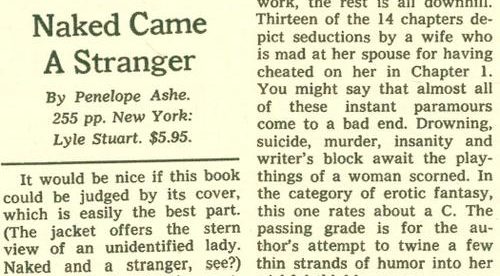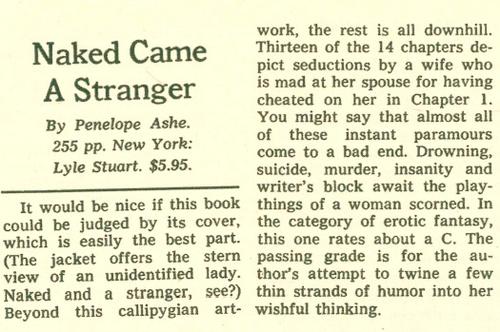The Intentionally Bad Novel That Became a Best Seller

If you take a look at the list of top-selling fiction writers of all time, the top two are hardly a surprise — William Shakespeare is tied with Agatha Christie. But after? In the third slot is Barbara Cartland, the late British romance novelist whose first novel was “a risqué society thriller” as described on her Wikipedia entry. Then comes Danielle Steele, another romance novelist, often described as a smut writer. In fifth is the late Harold Robbins, whose own posthumous author bio claimed “was as much a part of the sexual and social revolution as the pill, Playboy and pot.”
If you’re seeing a trend here, so did Penelope Ashe.
Or, she would have, if she were real.
Ashe is the author of a book titled “Naked Came the Stranger,” at least according to the book’s cover. Originally published in 1969, the novel is the story of… well, let’s just let Wikipedia describe it. (Oh, don’t click that link if you’re in a place where a picture of the naked backside of a woman would get you in trouble; that’s what the book’s cover had on it, and it’s on that Wikipedia entry.)
Gillian and William Blake are the hosts of a popular New York City breakfast radio chat show, The Billy & Gilly Show, where they play the perfect couple. When Gillian finds out that her husband is having an affair, she decides to cheat on him with a variety of men from their Long Island neighborhood. Most of the book is taken up by vignettes describing Gilly’s adventures with a variety of men, from a progressive rabbi to a mobster.
Not much of a plot, right? It’s just a collection of stories about trysts, apparently? That, it turns out, was the whole point of the book.
As above, Penelope Ashe doesn’t exist. “Naked Came the Stranger” was a hoax — it was really written by a group of journalists at Newsday, a major New York City-area paper. The project was spearheaded by a Newsday reported named Mike McGrady who had a simple idea: he wanted to show that, basically, sex sells.
McGrady, fed up with the overwrought, hyper-sexualized dime-store novels which had overtaken bestseller lists, decided to parody the genre. Instead of spending a lot of time writing a book with an actual storyline, he enlisted about two dozen of his colleagues to help. Together, they wrote the incoherent non-story summarized above, hoping people would buy it. You know, to prove the point.
The reviews weren’t very good. Here’s the New York Times’ one, below, from August 3, 1969, having no idea that the story was a sham:

Not a great review, to say the least. And yet, the book moved briskly, selling 20,000 copies before the summer was out.
McGrady and his cohort came clean shortly thereafter, but that only made the book more well-known — and more popular. “Naked Came a Stranger” hit the New York Times bestseller list, peaking at #3 over its 13-year run. As of McGrady’s death in 2012, the book, despite being pretty terrible, has sold more than 400,000 copies.
Bonus fact: In 2004, a publisher called PublishAmerica agreed to terms on a manuscript called “Atlanta Nights.” There’s not much of a story and grammar seems optional throughout. One chapter was written by a computer program which aimed to mimic the others, but it didn’t mimic Chapter 21 because there was no Chapter 21. There were, however, two Chapter 12s. Oh, and Chapter 17 is exactly the same as Chapter 4. The book was a mess. Why? It was written over a long weekend by a group of sci-fi writers who weren’t fans of PublishAmerica, believing that it was a second-rate company which would print just about anything. And it turns out they were basically right. (The authors pulled the book before it went to print, but a manuscript leaked; you can still find copies on Amazon.)
From the Archives: Fishing for Compliments: The fake book that became real.
